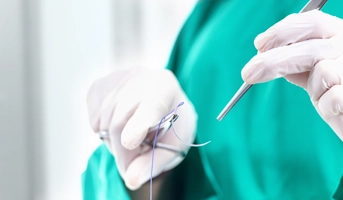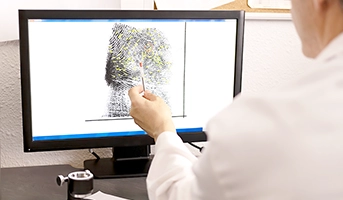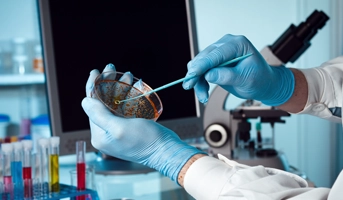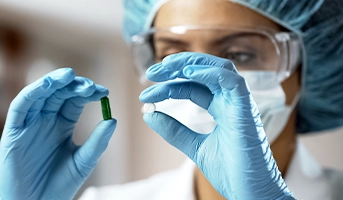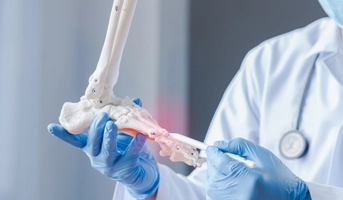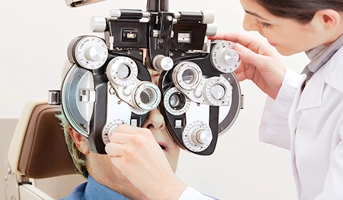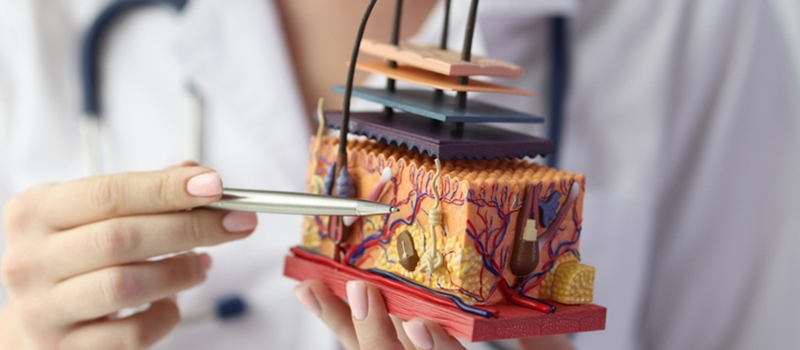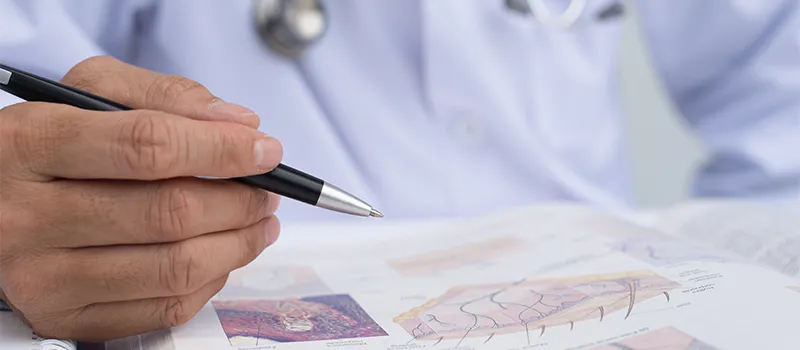

Everything You Need to Know about Dermatology MD
Doctor of Medicine in Dermatology, Venerology, and Leprosy is a three year postgraduate degree. Dermatology is the area of medicine that deals with illnesses of the skin, hair, and nails. The course provides students with cutting-edge techniques, skills, and research to treat patients suffering from skin diseases. With both medical and surgical components, it is a distinctive specialty. Initial medical, transitional, or surgical components make up the curriculum of the MD Dermatology. The course engages students through Journal Clubs, Subject Seminars, Student Symposium, Ward Rounds, Clinical Case Presentations, Clinico-Pathological Conference (CPC), Inter-Departmental Meetings, Pathology and Radiodiagnosis Cases, Teaching Skills, Conferences, and Clinical Postings.
In MD Dermatology, the final evaluation comprises of 3 parts:
1. Thesis: It must be submitted at least six months before the practical examination.
2. Theory Examination: PG Dermatology has four papers and each of three hours duration. Each paper consists of long essay questions, short essay questions and short notes.
| Paper | Subject |
| I | Basic Science as applied to Dermatology, STDs and Leprosy |
| II | Dermatology |
| III | STD & Leprosy |
| IV | Recent advances in field of Dermatology, Applied Sciences pertaining to skin/VD & internal medicine and skin |
3. Clinical/Practical and viva voce Examination: The practical examination comprises of long answer and short answer cases and 10 spots. Students are evaluated on their ability to interpret data, knowledge and application of instruments, clinical issues, radiological and biochemical tests, slides, medications, X-rays, and other information during oral/viva voce exams.
A medical professional can enroll in PG Dermatology e-lecture series to supplement their college lectures and practical sessions. Online e-lecture series benefits the medico learning at their own pace and maintaining the work-life balance. It also keeps them updated with the recent advances in the field and provides them the access to real life case scenarios. Audio-visual learning of the clinical cases and case demonstration leads to better comprehension and understanding.
DigiNerve’s Dermatology MD E-Lecture Series by Dr. Rashmi Sarkar and Dr. S. Sacchidanand
The Dermatology MD is an e-lecture series is crafted by Dr. Rashmi Sarkar and Dr. S. Sacchidanand, the Head Editors of Dermatology MD, in conjunction with India’s 78 esteemed professors.
The 14 modules that make up the 71 hour-long Dermatology MD e-lecture series include 109 topics that are significant from an academic, clinical, and surgical perspective. All of the series’ topics have been carefully chosen with the most frequently asked questions and informational needs of postgraduate students in mind. Examples include dealing with skin lesions, learning about rare diseases, and medico-legal issues.
The e-lecture series also provides 204+ benchmark trials and 570+ self-assessment questions to support the concepts. The cases have been thoroughly discussed, with a focus on the clinical findings and thorough workup required to make the proper diagnosis. With the help of surgical videos and animated sequences of various procedures, this online lecture series will also help practitioners improve their clinical and surgical dermatological skills. The concept understanding will take on a completely new dimension thanks to the in-video demonstration of the various surgeries being carried out.
To help students develop a thorough understanding of each topic and to meet their exam and clinical needs, the Dermatology e-lecture series are profusely illustrated with clinical, histopathological, and surgical images as well as flowcharts, tables, and boxes, as needed.
The 1000+ spotters now include a separate section of flashcards that includes illustrations of rare dermatology cases as well as all significant clinical presentations and lesions under each topic. The series includes a drug formulary to allow quick access to various medications during the ward rounds.
The key features of the e-lecture series include:
- 74+ Hours of Video Lectures
- 106 Well-Illustrated Notes
- 560+ Self-Assessment Questions
- 1000+ Spotters
- Interactive Drug Formulary
- 204+ Evidence-Based Studies/Benchmark Trials
- Engagement Activities
Dermatology MD E-Lecture Series Content
Orientation
- Orientation Video by Dr. Rashmi Sarkar
- Orientation Video by Dr. S. Sacchidanand
Module 1: Basics of Clinical Dermatology
- Growth and Development of Skin and Its Functions
- Skin and Its Interaction with Environment
Module 2: Dermatitis
- Atopic Dermatitis
- Contact Dermatitis
- Seborrheic Dermatitis
- Photodermatoses
- Prurigo nodularis: Management
- Pruritus and Prurigo and Their Management
- Occupational Dermatoses
- Nummular Eczema, Lichen Simplex Chronicus
Module 3: Psoriasiform and Lichenoid diseases
- Etiopathogenesis of Psoriasis
- Parapsoriasis and Pityriasis Lichenoides
- Pityriasis Rosea
- Lichen Planus and Lichenoid Disorders
- Management of Psoriasis
- Pityriasis Rubra Pilaris
Module 4: Pigmentary skin disorders
- Hypopigmentation and hyperpigmentation disorders
- Albinism and Genetic Pigmentation Disorders
Module 5: Vesicobullous Disorders
- Erythema Multiforme, Stevens–Johnson Syndrome, and Toxic Epidermal Necrolysis
- Pemphigus
- Paraneoplastic Pemphigus
- Bullous Pemphigoid
- Mucous Membrane Pemphigoid
- Epidermolysis Bullosa Acquisita
- Dermatitis Herpetiformis
- Inherited Epidermolysis Bullosa
Module 6: Autoimmune Skin Disorders and Rheumatologic Disorders
- Lupus Erythematosus
- Dermatomyositis
- Systemic Sclerosis
- Morphea and Lichen Sclerosus
- Psoriatic Arthritis and Reactive Arthritis
- Role of JAK Inhibitors in Dermatology
- Relapsing Polychondritis
Module 7: Hair, Nail, Mucosa, Adnexa and Connective tissue
- Acne and Acneiform Eruptions
- Rosacea and Related Diseases
- Disorders of Eccrine and Apocrine Glands
- Non Scarring Alopecia
- Scarring Alopecia
- Disorders of Eccrine & Apocrine Glands
- Hirsutism and Hypertrichosis
- Nail Dermatoses
- Dermal Hypertrophies
- Serology in Connective Tissue Disorders
- Panniculitis
- Lipodystrophies
- Disorders of Oral Cavity and Mucos
Module 8: Skin Neoplastic Diseases
- Premalignant Conditions of Skin
- Squamous Cell Carcinoma and Basal Cell Carcinoma
- Vascular Tumor and Malformations
- Malignant Melanoma
- Primary Cutaneous Lymphomas
- Mastocytosis
- Histiocytosis
Module 9: Skin and Systemic Diseases
- Skin Changes in Diabetes Mellitus and Endocrine Diseases
- Skin Changes in Systemic Diseases and Cutaneous Markers of Internal Malignancies
- Sarcoidosis
- Metabolic Disorders: Acquired
- Metabolic Disorders: Inherited
- Nutritional Disorders of Skin
Module 10: Vascular Diseases
- Raynaud’s Phenomenon
- Chronic Non Healing ulcers: How to Optimise Healing
- Vasculitis
- Sclerotherapy: Role in Dermatology
- Neutrophilic Dermatoses
Module 11: Infectious diseases of skin
- Mycobacterial Skin Diseases
- Leprosy- Disability and Rehabilitation
- Superficial Fungal Infections
- Deep Fungal Infections
- Leishmaniasis and Other Protozoal Infections
- Scabies, Pediculosis, and Other Infestations
- Bites and Stings
Module 12: Sexually transmitted diseases
- Syphilis
- Chancroid
- Lymphogranuloma Venereum
- Granuloma Inguinale (Donovanosis)
- Cutaneous manifestations of COVID 19
Module 13: Topical and Systemic treatments
- Principles of Topical Therapy in Dermatology
- Glucocorticoids
- Retinoids
- Topical Antibacterials
- Systemic Antibacterials
- Management of Lepra Reactions
- Antifungal Agents
- Cytotoxic and Antimetabolic Agents
- Antiviral Drugs
- Molecular Targeted Therapies
- Antiangiogenic Agents
- Sunscreen in Dermatology
- Management of Chronic Urticaria
Module 14: Procedural Dermatology
- Perioperative Considerations in Dermatologic Surgery
- Laser hair removal
- Excisional Surgery and Repair, Flaps, and Grafts
- Management of Keloids
- Laser and Light-Based Treatments: Hair Removal Optimisation
- Laser and Light-Based Treatments: Qs Nd YAG- Basics, Pearls and Indications
- Laser and Light-Based Treatments: Energy Based Devices- Scars and More
- Surgical management of Vitiligo
- Noninvasive Body Contouring
- Chemical Peeling
- Microneedling
- Evolution of Liposuction: Manual-Powered-Laser
- Fat Transfer
- Botulinum Toxin in Dermatology
- Surgical management of acne scars
- The journey of resurfacing: From manual to Lasers and EBDS
Drug Formulary
Objectives of MD Dermatology E-Lecture Series
- The student should be familiar with the fundamental sciences as they relate to dermatology, including anatomy, physiology, biochemistry, microbiology, pathology, and pharmacology.
- The learner should become deeply knowledgeable about his or her subject including recent developments and latest techniques.
- The student should be well-versed in all bedside practices, including diagnostic and therapeutic ones, and knowledgeable of the most recent diagnostic and therapeutic options.
- The student should have gained procedural and practical knowledge of the subject using pertinent investigations, critically analyse, start an investigation, and clinically manage cases of leprosy, venereology, and dermatology.
- Plans and recommendations for patient rehabilitation and prevention should be made.
- Capable of ensuring the execution of national health programmes, notably in leprosy and sexually transmitted diseases (STDs).
- Develop your training in the following areas: professionalism, attitude, research methods, and communication skills.
- The student must be able to analyse published studies, develop a research project, explore library and internet resources, and understand the fundamentals of research technique.
- Should be able to conduct ethical dermatological practice.
- Acknowledge the patients’ medical demands and fulfill professional duties in accordance with professional ethics and the National Health Policy’s guiding principles.
- The student should gain competency in teaching medical/paramedical students and master the fundamentals of teaching approach.
- Needed to have developed problem-solving abilities.
Best Way to Study MD Dermatology
Along with attending the regular lectures, practical sessions, postings and seminars, a postgraduate dermatology student should also keep in mind the following points:
- A Postgraduate Specialist who has completed the necessary training should be able to identify the community’s health needs, be competent to handle medical issues effectively, and be aware of recent developments in his field of expertise.
- A medical student should have a solid foundation in teaching medical and paramedical students.
- Additionally, he or she should be familiar with the fundamentals of research methodology and library consultation techniques.
- PG Dermatology students should actively participate in all lectures, seminars, symposia, interdepartmental meetings, and other events. They are exposed to modern developments by taking part in symposiums, CMEs, and journal clubs. This will enable them to concentrate on the objectives, approaches, comments, interactions, and conclusions.
- In order to have an impact on patient management, postgraduate students should engage in bedside conversations during rounds and outpatient instruction.
- A thorough history and case record should be kept by the medical student.
- Always uphold ethical principles, maintain appropriate demeanor when interacting with patients, family members, and other healthcare professionals, and respect the patient’s rights, including the right to information and a second opinion.
- Learn how to conduct a physical examination, make a diagnosis, and manage patients with leprosy, venereology, and dermatological conditions.
- Medico must possess a systematic ability to recognize, group, and distinguish cutaneous findings using dermatological terminology.
- A medical practitioner must be able to conduct systemic exams (chest, cardiac, abdomen, neurological, genitalia, oral, and eye exams) pertinent to dermatologic conditions.
- A medico must learn handling emergencies involving the skin, including Angioedema, Toxic Epidermal Necrolysis (TEN), Stevens-Johnson syndrome (SJS), Pemphigus, drug reactions, and Necrotic Erythema Nodosum Leprosum (ENL).
- They must be able to independently carry out routine laboratory tests related to cutaneous diagnosis, such as Potassium hydroxide (KOH) mount, Woods lamp examination, Gram stain, Giemsa stain, stains, Culture media, Acid fast bacilli stain etc.
- Must be able to request pertinent investigations and interpret the results to make a diagnosis. Must be knowledgeable about other recent investigations.
- A medico must learn to make incisions and apply sutures and stitches and should receive training in performing skin and nail biopsies.
- Ability to independently perform manual dermabrasion, skin punch grafting, chemical peels, and wound dressing.
- It is advised to get a clear hand in conducting slit smears, tissue smears, patch and photopatch tests, chemical cauterization, cryotherapy, and these tests.
Frequently Asked Questions (FAQs):
Q1. How many years is MD in dermatology?
Ans. MD Dermatology is a three year postgraduate course in the medical field.
Q2. What are the subspecialty in dermatology in India?
Ans. The subspecialities in field of Dermatology are Pediatric Dermatology, Dermatosurgery, Cosmetic Dermatology, Dermatopathology, Laser Dermatology, Trichology, and Mohs Surgery.
Q3. What is the salary of a MD in Dermatology in India?
Ans. The average salary of a MD Dermatology in India is around 10-12 lakhs. The salary of a medical professional differs due to various factors, such as geographical area, public or private sector, job profile, experience and more.
Related Courses
Cosmetic Botulinum Toxin Simplified
Dr Rasya Dixit , Dr Urmila Nischal , Dr K. C Nisch...
Critical Care Simplified
Dr Yatin Mehta , Dr Subhal Dixit , Dr Kapil G. Zir...
Advance Course in Ultrasound and Infertility
Dr Sonal Panchal , Dr Chaitanya Nagori
Ganga Videos on Spine Surgery
Prof Rajasekaran Shanmuganathan , Dr Ajoy Prasad S...
Pathology for UnderGrads
Prof Harsh Mohan , Prof Ramadas Nayak , Dr Debasis...
Microbiology for UnderGrads
Dr Apurba S Sastry , Dr Sandhya Bhat , Dr Deepashr...

